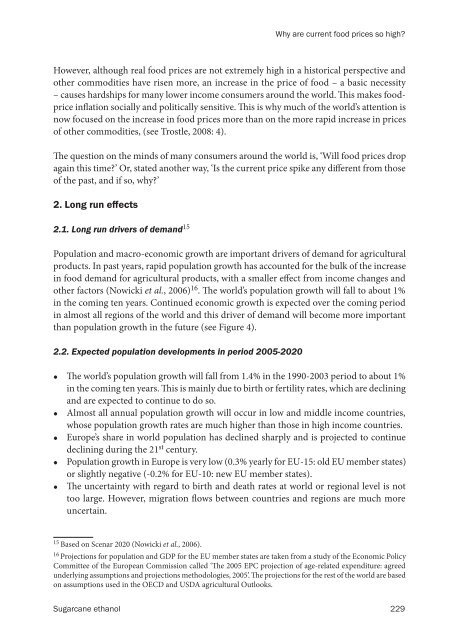Sugarcane ethanol: Contributions to climate change - BAFF
Sugarcane ethanol: Contributions to climate change - BAFF
Sugarcane ethanol: Contributions to climate change - BAFF
You also want an ePaper? Increase the reach of your titles
YUMPU automatically turns print PDFs into web optimized ePapers that Google loves.
Why are current food prices so high?<br />
However, although real food prices are not extremely high in a his<strong>to</strong>rical perspective and<br />
other commodities have risen more, an increase in the price of food – a basic necessity<br />
– causes hardships for many lower income consumers around the world. �is makes foodprice<br />
in�ation socially and politically sensitive. �is is why much of the world’s attention is<br />
now focused on the increase in food prices more than on the more rapid increase in prices<br />
of other commodities, (see Trostle, 2008: 4).<br />
�e question on the minds of many consumers around the world is, ‘Will food prices drop<br />
again this time?’ Or, stated another way, ‘Is the current price spike any di�erent from those<br />
of the past, and if so, why?’<br />
2. Long run effects<br />
2.1. Long run drivers of demand 15<br />
Population and macro-economic growth are important drivers of demand for agricultural<br />
products. In past years, rapid population growth has accounted for the bulk of the increase<br />
in food demand for agricultural products, with a smaller e�ect from income <strong>change</strong>s and<br />
other fac<strong>to</strong>rs (Nowicki et al., 2006) 16 . �e world’s population growth will fall <strong>to</strong> about 1%<br />
in the coming ten years. Continued economic growth is expected over the coming period<br />
in almost all regions of the world and this driver of demand will become more important<br />
than population growth in the future (see Figure 4).<br />
2.2. Expected population developments in period 2005-2020<br />
•<br />
•<br />
•<br />
•<br />
•<br />
�e world’s population growth will fall from 1.4% in the 1990-2003 period <strong>to</strong> about 1%<br />
in the coming ten years. �is is mainly due <strong>to</strong> birth or fertility rates, which are declining<br />
and are expected <strong>to</strong> continue <strong>to</strong> do so.<br />
Almost all annual population growth will occur in low and middle income countries,<br />
whose population growth rates are much higher than those in high income countries.<br />
Europe’s share in world population has declined sharply and is projected <strong>to</strong> continue<br />
declining during the 21 st century.<br />
Population growth in Europe is very low (0.3% yearly for EU-15: old EU member states)<br />
or slightly negative (-0.2% for EU-10: new EU member states).<br />
�e uncertainty with regard <strong>to</strong> birth and death rates at world or regional level is not<br />
<strong>to</strong>o large. However, migration �ows between countries and regions are much more<br />
uncertain.<br />
15 Based on Scenar 2020 (Nowicki et al., 2006).<br />
16 Projections for population and GDP for the EU member states are taken from a study of the Economic Policy<br />
Committee of the European Commission called ‘�e 2005 EPC projection of age-related expenditure: agreed<br />
underlying assumptions and projections methodologies, 2005’. �e projections for the rest of the world are based<br />
on assumptions used in the OECD and USDA agricultural Outlooks.<br />
<strong>Sugarcane</strong> <strong>ethanol</strong> 229












